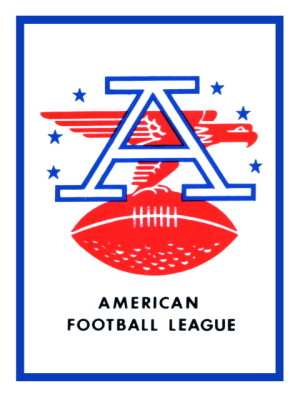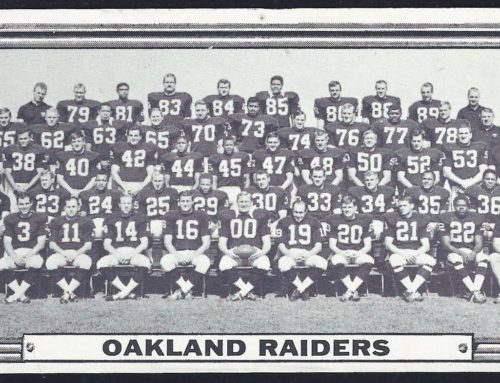 I was bouncing around on Twitter recently when I came across an interesting post by Pro Football Journal that linked to an article on the Pro Football Journal blog. The article was titled, How Many Hall of Famers in These Screen Caps? Basically it showed two different images of a Rams vs. Colts game in 1966. The first two images showed Colts offense vs. Rams defense and Colts defense vs. Rams offense and asked how many Hall of Fame members (active players only, coaches and sideline players not included) could be counted on the two photos. Between the two photos there were 11 Hall of Fame members.
I was bouncing around on Twitter recently when I came across an interesting post by Pro Football Journal that linked to an article on the Pro Football Journal blog. The article was titled, How Many Hall of Famers in These Screen Caps? Basically it showed two different images of a Rams vs. Colts game in 1966. The first two images showed Colts offense vs. Rams defense and Colts defense vs. Rams offense and asked how many Hall of Fame members (active players only, coaches and sideline players not included) could be counted on the two photos. Between the two photos there were 11 Hall of Fame members.
The density of HOF players on those photos seemed rather high. At first I wondered if the AFL could offer a similar set of photos, but then I took that thought a step further. Fans often complain that too many of their favorite AFL players are worthy of induction, but have thus far been overlooked by the Hall of Fame. Along those lines, the Talk of Fame Network recently ran an exercise to determine the 10 best AFL players that are not in the Hall of Fame. But aside from listing individual names, is the AFL truly under represented in the Hall of Fame? Does the NFL really have more players than the AFL? What are the actual numbers?
League Sizes
I decided to conduct a little research project of my own to see what I could find. Granted a fair number of players were active in both leagues, but asking a few questions revealed that during the decade of the 1960s, there were 1720 different men who could be found on an NFL team roster and 1396 men on AFL rosters during the same period. That made sense as there were more teams in the NFL than in the AFL each year.
| AFL Teams | NFL Teams | |
| 1960 | 8 | 13 |
| 1961 | 8 | 14 |
| 1962 | 8 | 14 |
| 1963 | 8 | 14 |
| 1964 | 8 | 14 |
| 1965 | 8 | 14 |
| 1966 | 9 | 15 |
| 1967 | 9 | 16 |
| 1968 | 10 | 16 |
| 1969 | 10 | 16 |
Additionally, from 1960-1965 the NFL allowed more active players-per-roster than the AFL. That number was standardized at 40 once the merger agreement began in 1966, but up until that point the roster sizes were as follows:
| AFL Rosters | NFL Rosters | |
| 1960 | 35 | 38 |
| 1961 | 33 | 36 |
| 1962 | 33 | 36 |
| 1963 | 33 | 37 |
| 1964 | 34 | 40 |
| 1965 | 38 | 40 |
| 1966 | 40 | 40 |
| 1967 | 40 | 40 |
| 1968 | 40 | 40 |
| 1969 | 40 | 40 |
Balancing the Fields
The next step I took was to count the number of Hall of Fame members who played even a single game in the 1960s. The total there was 111 different players. I divided that list into players who were generally AFL people and NFL people. Again, if a player played even a single game in the AFL, then I considered him to be an AFL player. For example, John Henry Johnson played in the NFL from 1954-1965, but he was a Houston Oiler in 1966. Therefore I counted him as an AFL player. In separating the players by league, I learned that 30 “AFL” players could be found in the Hall of Fame, as opposed to 81 NFL players from the same time period.
But this still wasn’t exactly an apples-to-apples comparison. In both groups were several men whose careers barely touched the 1960s. The bulk of their careers could have occurred either before or after that decade. To remedy this situation and attempt to balance the scales, I applied the following rule:
To be considered for one group or another, a player had to have spent a minimum of five seasons during the 1960s in a given league. If they did not meet that criteria, they they were removed completely from the exercise. I felt that this was the best way to define a player as generally AFL or NFL. Examples include:
- Charlie Joiner began his career with the Houston Oilers in 1969, but played through 1986. He was removed.
- Leo Nomellini played from 1950-63, but he played only four seasons in the 1960s. He was removed.
From the AFL list I removed Curley Culp, Floyd Little, Emmitt Thomas, Elvin Bethea, Charlie Joiner, Larry Little, Jan Stenerud, Bob Griese, Art Shell, Larry Csonka, Gene Upshaw, Ken Houston, Willie Lanier, O.J. Simpson and John Henry Johnson*.
From the NFL list I removed Claude Humphrey, Charlie Sanders, Roger Wherli, Rayfield Wright, Ron Yary, Tom Mack, Lem Barney, Ted Hendricks, Bob St. Clair, Alan Page, Joe Greene, Roger Staubach, Mike McCormack, Norm Van Brocklin, Leo Nomellini, Joe Perry, Ernie Stautner, Art Donovan, Chuck Bednarik, Bobby Layne and Emlen Tunnell.
*As John Henry Johnson played from 1960-1965 for the Pittsburgh Steelers, he was re-added to the NFL list where he rightfully belonged.
Removing those who did not fit the criteria left 15 AFL players and 61 NFL players. To determine the density of HOF for each league in the 1960s, I took the total number of players and subtracted the HOF who did not fit the criteria. Then I divided that number into the number of remaining HOF for each league.
Hall of Fame Density
NFL
- 1720 players – 21 that did not match criteria = 1699 players
- 61 NFL HOF divided by 1699 players = 3.590% HOF density in the NFL during the 1960s
AFL
- 1396 players – 14 that did not match criteria = 1382 players
- 15 AFL HOF divided by 1382 players = 1.085% HOF density in the AFL during the 1960s
The result is that the NFL has roughly 300% more HOF than the AFL for the same period of time.
What could possibly account for a 300% difference in HOF representation between the two leagues? The larger number of players in the NFL and the fact that the AFL was a brand new league in 1960 would be contributing factors, but not enough to account for a 300% difference. Also of note is that of the leagues’ two All-Decade teams, the AFL has 14 members in the HOF while the NFL has 28. Could anyone honestly state that the NFL was 200%-300% better than the AFL when the Super Bowl tally for the two leagues was even at two apiece? I don’t believe so.
Reasons for the Imbalance
Truth be told, I believe that an anti-AFL bias among HOF voters is the real reason for the difference. A glimpse at the Hall of Fame committee in the days post-merger actually sheds a considerable amount of light on the situation.
- At the close of the 1960s and moving forward, the HOF Selection Committee consisted of voters from 16 longtime NFL cities and 10 AFL cities.
- With the first HOF induction class being recognized in 1963 and the first AFL player (Lance Alworth) not inducted until 1978, the HOF Selection Committee had a 15-year run to set the tone before finally recognizing an AFL player.
- Five HOF voters representing longstanding NFL teams (John Steadman – Baltimore, Chuck Heaton – Cleveland, George Puscas – Detroit, Art Daley – Green Bay and Bob Oates – Los Angeles) were active voters from the merger (1970) through at least 1990.
- The Pro Football Hall of Fame is located in Canton, Ohio, the city where the NFL was founded. The AFL when founded, was viewed as a direct threat to the success of the NFL. Ultimately a merger came to be, but long-held animosities against the AFL were not immediately cast aside when the two leagues became one.
- With each new year, old voters are replaced by younger people who may well know recent NFL stars but have no real understanding of the AFL or its individual players.
What Can Be Done?
It is apparent that the anti-AFL bias among HOF voters is responsible for the league’s under-representation in Canton. The question now is what can be done to remedy the situation? As things currently stand, not a lot. Under current guidelines the HOF Senior Committee is able to nominate a maximum of two players per year for induction, though that is subject to a reduction of one senior per year. With more than 40 years worth of more recent candidates in that same pool, the chances of AFL players getting the attention they deserve in a voting session is small. A change has to be made or an AFL-specific induction class designed.
I am in favor of the HOF dedicating a single year to recognize only AFL players, similar to what the Baseball Hall of Fame did with the great Negro League stars in 2006. My preference would be to see the Senior Committee spend as much time as necessary to truly study deserving AFL candidates and induct those who are worthy of the honor. Do not put a number of the induction class, such as the 10 or 20 most deserving, but rather honor those who truly make the cut, whatever the number, and then be done with the situation. Spend the time needed, recognize the most deserving, and be proud of a job well done. My last hope would be that such a class is recognized as quickly as possible. Former AFL’ers, if still living, are into their mid-70s and older. Time waits for no man, Hall of Famer or not. Get this done while those still with us can appreciate the honor. The league has been a memory for 50 years and these men have waited long enough.

